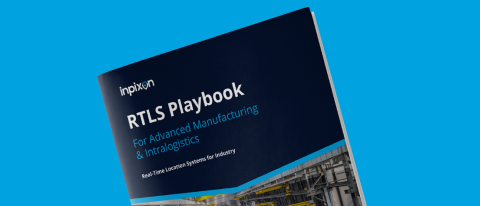In the Real-Time Location Systems (RTLS) world, there is a lot of technical terminology that might seem intimidating at first. To demystify some of this jargon we take a look at some of the more popular terms used when talking about RTLS technology and explore what each technology is, the different use cases, and what differentiates Inpixon from other similar technologies.
What is a blink?
A blink is a data packet that is sent in a regular interval from a sender to a receiver. Blink rates define how often a tag sends out a transmission to create an update on its location. Inpixon’s asset or personnel tags, for instance, can be configured by the user to set more than one blink rate, because different use cases require different refresh intervals – some faster for more continuous visibility and some slower when it’s not necessary.
Inpixon’s tags can also tell if an asset is moving or stationary based on internal RTLS sensors, so there are in fact two blink rates you can set – one for when the tag is moving and one for when it is stationary. The tag can automatically shift between these two configured blink rates depending on whether it sees itself as moving or stationary.
This is notable because if you know the asset is not moving, you likely won’t need those frequent updates - which is beneficial to prolonging battery life. The tag can automatically shift between these two configured blink rates depending on whether it sees itself as moving or stationary.
Battery life is one of those top-of-mind things for RTLS organizations, as it affects scalability, cost, reliability and more. Inpixon’s tags for example can achieve over 5 years of battery life using the default blink rates, which can be extended by configuring the blink rates to exactly match the use case of the application targeted.
What is a chirp?
A chirp can be described as a radio frequency (RF) signal where the frequency increases or decreases with time. Inpixon’s asset tag leverages this long-range Chirp Spread Spectrum (CSS) scheme. In nature, this chirp is used by bats to help orient themselves. This facilitates the real-time tracking of the location and movements of critical mobile assets across large facilities such as warehouses, manufacturers, hospitals, and other process-driven environments.
Inpixon’s unique application of 2.4GHz chirp-enabled RF technology for long-range accessibility with protection against Radio Frequency (RF) interference and indoor to outdoor support, allows businesses to track critical assets throughout large facilities.
- Unique RF technology: The bandwidth of CSS is much higher (60 MHz) compared to LoRa (short for long range) or BLE, which means we can transmit with higher data rate (up to 1 Mbit/s) and achieve much better accuracy (1-2m) which is unique for Inpixon Chirp.
- Tracking and data communication: Inpixon’s CSS uses an optimized transmission signal system optimized for time measurements within data communication. Meaning we can do locating and communication concurrently.
- The Doppler tolerant: Quality of the location is constant and independent of whether the tagged object is steady or fast moving.
What is an anchor?
Anchors are fixed infrastructure devices in an RTLS system. They are electronic devices that detect Chirp Spread Spectrum (CSS) pulses emitted by chirp tags and forward them to a location engine to determine tag positions. Their main function is to receive blinks from location tags and forward them to the RTLS location engine. The engine then performs the wireless synchronization of all anchors and calculates the tag position using the time difference of arrival (TDoA) location method.
Now let’s put this together. The tags send chirp messages (blinks) to the anchors. The anchors receive these chirp blinks, process the information, and send the information to the RTLS server. The server then calculates the precise position based on the chirp blink message; this location data can then be visualized on an indoor map as a blue dot.
The difference between blinks, chirps, and anchors
The relationship is close between anchors, chirps, and blinks. In simple terms - anchors are the backbone that receives blinks from the tags. Tags transmit in regular intervals (or refresh rates) using brief ‘blink messages.’ These blinks are processed by all anchors within communication range. The anchors then send all the timestamps to the RTLS server. With this information, organizations can utilize all the benefits associated with RTLS. The used RF technology is nearly independent from this concept – however, Inpixon offers a unique chirp RF solution next to UWB RF.
Within certain industries, such as manufacturing, healthcare, and mining, using these technologies help organizations to track assets. Efficient asset management can deter theft, aid in loss recovery, identify workflow bottlenecks, ease inventory management, and increase asset utilization.
Schedule a 20-minute meeting with our sales team to learn how our RTLS solutions can aid in efficient asset management.


-3.png?length=1000&name=Inpixon%20LinkedIn%20Banner%20August%202025%20(2)-3.png)

